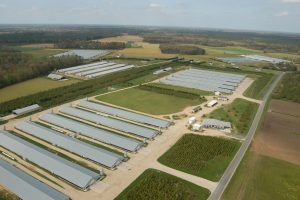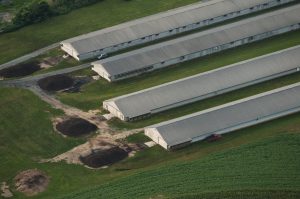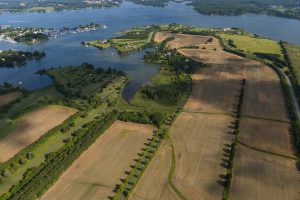Chesapeake Bay
More than 100,000 streams, creeks and rivers drain into the Chesapeake Bay, a 64,000 square mile watershed covering parts of Virginia, Maryland, Delaware, Pennsylvania, West Virginia, New York, and Washington, D.C.
The Chesapeake Bay is the nation’s largest estuary and a key to the region’s identity and economy. But runoff from agricultural land and urbanized areas, as well as discharges from large industrial point sources and sewage treatment plants, has overloaded the Bay and its tributaries with nitrogen, phosphorus, and sediment. This pollution threatens aquatic life, fishing, and the public’s ability to enjoy one of the nation’s most treasured waters.
In 2010, the U.S. Environmental Protection Agency (EPA) established pollution limits (known as the Bay “Total Maximum Daily Load” or TMDL) to ratchet down the maximum amount of nitrogen, phosphorus, and sediment pollution that the Bay states are allowed to discharge into the estuary. These limits are meant to improve bay water quality so it can again support aquatic life, fisheries, and recreation as required by the federal Clean Water Act. The Bay states must meet 60 percent of their targeted reductions by 2017, and put all programs in place by 2025 to fully restore the Bay and its tidal rivers to health.
The Environmental Integrity Project is helping this process by acting as a watchdog, making sure that the states are keeping their commitments to reduce pollution, industrial dischargers are fully complying with their limits, and factory farms are not thwarting this progress. To this end, we have issued data-rich reports on important issues, such as runoff pollution from the poultry industry; brought big polluters into line and held federal and state regulators to their obligations through lawsuits, permit challenges, and petitions; and worked with allies to promote legislation to accelerate the Bay cleanup.
Agriculture and Factory Farms
 The agricultural industry — including both traditional farming operations and large-scale Concentrated Animal Feeding Operations (also known as CAFOs, or “factory farms”) — is the source of roughly half of the nitrogen and phosphorus pollution that robs Bay waters of the oxygen needed to sustain fish, crabs, and other aquatic life. Agriculture is also the leading source of the sediment pollution harming the Bay’s water quality. EIP works with a broad coalition of stakeholders seeking to ensure that agriculture does its fair share to clean up the Bay. In particular, we have worked to ensure that state authorities require, and large factory farms obtain, discharge permits under the Clean Water Act. As permits require best management practices to reduce runoff pollution, proper permitting of factory farms is crucial. And because permitted facilities are more transparent, regulators can better assess and reach their cleanup goals. For example, EIP sought to achieve greater transparency in Maryland by litigating the state’s illegal withholding of public agricultural pollution management data.
The agricultural industry — including both traditional farming operations and large-scale Concentrated Animal Feeding Operations (also known as CAFOs, or “factory farms”) — is the source of roughly half of the nitrogen and phosphorus pollution that robs Bay waters of the oxygen needed to sustain fish, crabs, and other aquatic life. Agriculture is also the leading source of the sediment pollution harming the Bay’s water quality. EIP works with a broad coalition of stakeholders seeking to ensure that agriculture does its fair share to clean up the Bay. In particular, we have worked to ensure that state authorities require, and large factory farms obtain, discharge permits under the Clean Water Act. As permits require best management practices to reduce runoff pollution, proper permitting of factory farms is crucial. And because permitted facilities are more transparent, regulators can better assess and reach their cleanup goals. For example, EIP sought to achieve greater transparency in Maryland by litigating the state’s illegal withholding of public agricultural pollution management data.
Air and Water Pollution
The nation’s 18,500 factory farms produce a staggering 300 million tons of waste each year. Manure from factory farms is stored in large pits, stockpiles, or lagoons (sometimes as large as several football fields), waiting to be spread or sprayed onto fields and crops. Much of the nitrogen and phosphorus in this waste migrates to surface water, where it creates algae blooms and dead zones, and often contaminates groundwater along the way. In addition, animal waste can pollute groundwater and surface water with heavy metals, pharmaceuticals, hormones, and pathogens.

The storage and land disposal of such large quantities of animal waste also results in industrial-scale air emissions, including pollutants such as ammonia, hydrogen sulfide, volatile organic compounds, and particulate matter. In addition to impacting air quality, much of this pollution also winds up in the Bay. Ammonia emissions, for example, are one of the leading sources of nitrogen in the Chesapeake Bay.
Changing Business as Usual
Despite widespread pollution problems, factory farms have largely escaped the most basic requirements of the Clean Water Act, Clean Air Act, and the right-to-know laws. EIP works to bring the agricultural industry into compliance with these laws, which helps create a more even playing field for sustainable farmers. This includes efforts to strengthen factory farm regulations at the state and national levels. For example, we petitioned EPA to object to Virginia’s failure to regulate factory farms through Clean Water Act permits; as a result, Virginia started to issue permits for these operations. This will help minimize pollution loads and increase the public’s ability to monitor compliance with the law. We are also involved in legal action at the federal level to ensure that CAFOs are held to the same standard as other industries. Among other things, we are working to ensure that CAFOs meet pollution-reporting obligations, and we are pushing EPA to take a more active role in regulating ammonia and other air pollution from CAFOs.
Industrial Polluters
Discharges from industrial facilities account for about 15 percent of the nitrogen and phosphorus pollution in the Bay. These “point sources” include municipal wastewater treatment plants, chemical manufacturers, and other industrial facilities. Recent upgrades have reduced pollution from many of these point sources, but much work remains toward ensuring that all facilities have properly stringent limits written into their permits and comply with these limits. EIP tracks and analyzes pollution data for major sources to assess progress in cleaning up the Chesapeake Bay, while also calling attention to those plants that have fallen behind or are violating permit limits.
For example, in October 2015, we finalized a federal Consent Decree with the Washington Suburban Sanitary Commission’s water filtration plant in Potomac, Maryland, in order to reduce the plant’s discharges of sediment, aluminum, and phosphorus to the Potomac River by millions of pounds. In December 2015, EIP discovered that the National Archives facility in College Park, Maryland was discharging toxic pollution to the Anacostia River in exceedance of its permit limits. After EIP notified National Archives of our intent to bring a Clean Water Act citizen lawsuit against the agency, the facility stopped discharging all wastewater to the Anacostia and now runs a zero-discharge operation.
Washington Suburban Sanitary Commission October 2015 Consent Decree
National Archives April 2016 Letter to EIP Confirming Zero-Discharge Operation
In Baltimore, EIP investigated illegal and unreported sewage dumping by the city into the main tributary to the Inner Harbor. The tens of millions of gallons released were despite a consent decree the city signed with EPA and the state that was supposed to end all sewage spills and overflows by January 1, 2016. We have been working with allies in the city to push EPA and the Maryland Department of the Environment to strengthen a revised consent decree and make sure the city finally cleans up this public health problem. Read more about the Baltimore city sewage cleanup on our Environmental Justice page.
Strengthening State Programs

Maryland, Virginia, Pennsylvania, Delaware, New York, West Virginia, and the District of Columbia must take specific actions to meet their Chesapeake Bay cleanup obligations. Some states are falling short of what will be necessary to restore the Bay. To keep the states on track to meet their goals, we participate in the development of state and EPA policies that include, for example, pollution trading markets, limits on manure application where the soil is saturated with phosphorus, and systems that account for pollution-reduction practices on farmland.


